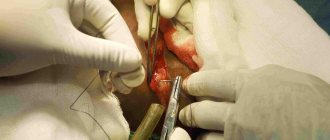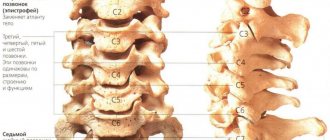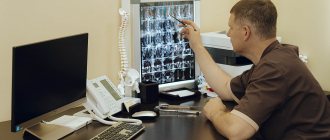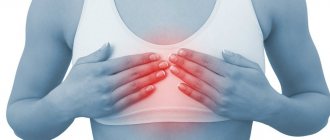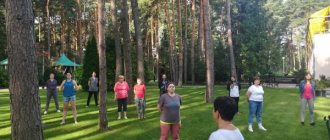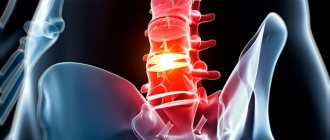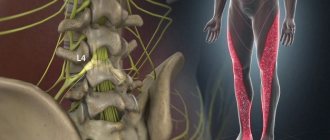Cervical osteochondrosis is a degenerative and dystrophic disease of one of the parts of the spine. As the disease develops, the intervertebral discs in the neck suffer the most, and damage also spreads to the articular surfaces, ligaments, and vertebrae.
Cervical osteochondrosis is a degenerative and dystrophic disease of one of the parts of the spine. As the disease develops, the intervertebral discs in the neck suffer the most, and damage also spreads to the articular surfaces, ligaments, and vertebrae. Treatment of osteochondrosis of the cervical spine depends on the current stage of the disease. The pathology mainly occurs in patients over the age of 30, but cases are also recorded in young people, especially if the person leads an unhealthy lifestyle and is at risk.
The most common symptom is severe pain in the neck, which can spread lower down the spine, move to the upper limbs, and deform into a severe headache. Below we will consider for which symptoms of osteochondrosis of the cervical spine it is better to begin treatment, find out the causes of the disease and the methods that are used to combat the problem.
Causes and risk factors
The main reason for the development of osteochondrosis in humans is the ability to walk upright, acquired with evolution. When walking, the vertebrae put excessive pressure on each other. Every year this leads to the fact that the amount of intervertebral fluid and connective tissue between the vertebrae decreases, as a result, the bones begin to rub against each other, causing severe pain.
The longer cervical osteochondrosis develops without the necessary treatment, the less chance there is to stop the degenerative processes. In old age, it is almost impossible to restore connective tissue.
Cervical osteochondrosis in old age is predominantly a natural process that is not associated with the influence of external factors. If the problem begins to develop at an early age, if the painful sensations intensify too quickly, it is imperative to look for the cause of this disorder.
The development of cervical osteochondrosis at an early age is most often caused by the following factors:
- Lack of physical activity in daily life. In the modern world, a person leads a predominantly sedentary lifestyle - he works all day in an office, spends time in the evening sitting on the couch or at the computer, and often drives a car;
- In the process of performing work tasks, the human body often takes an unnatural, tense position (strong forward deviation when working at a computer);
- Excessive exercise. The opposite reason is playing sports with uncontrolled loads. Not only ordinary citizens, but also professional athletes face this problem;
- The reasons that cause the spine to be in the wrong position are flat feet, wearing uncomfortable high-heeled shoes, scoliosis, arthritis, etc.;
- Abuse of junk food, obesity;
- Severe hypothermia of the cervical spine;
- Nervous stress – frequent stress in everyday life and at work, lack of proper sleep at night.
Symptoms of cervical osteochondrosis
All of these risk factors and lifestyle features lead to the intervertebral discs in the cervical spine experiencing nutritional deficiency. If the problem is not identified and corrected, the discs will gradually begin to deteriorate, the distance between them will decrease, and ultimately this will lead to constant friction of the bones against each other. As connective tissue depletes, bone growths begin to form on the spine, which are prone to uncontrolled growth. In advanced cases, the growths begin to put pressure on the surrounding tissues, vessels, and nerves that are located in the cervical spine.
Cervical osteochondrosis does not develop instantly; in the absence of proper treatment for the symptoms of osteochondrosis of the cervical spine, the problem worsens. The entire course of the disease can be divided into 4 stages. The symptoms experienced by the patient directly depend on the current stage of the problem. Among the symptoms of cervical osteochondrosis are:
- Discomfort in the neck that spreads to the shoulder area;
- The appearance of pain in the cervical spine when playing sports;
- Stiffness when turning the neck;
- Private headaches that are not caused by external factors;
- When you change the position of your head, you can hear a characteristic crunch;
- Numbness and loss of sensitivity in some areas of the skin of the neck, shoulders, arms, neck;
- Hypoxia of tropho-dependent organs;
- Development of pathologies of the circulatory system;
- Severe pain leads to complete immobilization of the upper shoulder girdle.
The further the disease progresses, the more discomfort the patient experiences. In the final stages of the problem, the patient’s quality of life deteriorates significantly. Common symptoms for all stages of the problem include headache, ringing or noise in the ears, visual defects, nausea and vomiting with a sudden change in head position.
Recommendations
To strengthen the neck muscles, it is recommended to use therapeutic exercises, before starting which you need to consult with the doctors of the Mart clinic. If during this exercise you experience severe pain in the neck area, stop exercising and consult a doctor again.
The article was reviewed by Doctor of Medical Sciences, Professor Grigory Isaakovich Shvartsman, Northwestern Medical University. I.I. Mechnikov.
Sign up at the MART medical center in St. Petersburg (see map) by phone, or leave a request on the website.
Diagnosis of osteochondrosis of the cervical spine
If you experience one of the symptoms listed above, it is advisable to immediately seek medical help. The sooner a problem is diagnosed, the higher the likelihood of it being completely eliminated. A neurologist is involved in the diagnosis and treatment of cervicothoracic osteochondrosis of the spine.
After the patient contacts, the neurologist will interview the patient and, based on his complaints, make a conclusion about the presence of the disease. Most often, patients complain of pain, discomfort, and problems with movement of the upper limbs. After the interview, the doctor will conduct a visual examination of the patient. Will be assessed:
- Correct posture;
- At what angle are the shoulder blades, shoulders and ilia bones located?
- The location of the line of the spinous processes along the length of the spine.
A visual examination allows you to determine what pathological processes began in the spine and how much they affected the spine and surrounding tissues.
The final diagnosis is not made solely on the basis of examination and questioning of the patient. Additional examinations are required. Most often, the patient is sent for radiography and computed tomography. If for one reason or another it is impossible to make a final diagnosis, the patient is referred for magnetic resonance imaging. Additional examinations include Doppler sonography; the procedure allows you to find out the state of the circulatory system in the cervical region.
Establishing diagnosis
If you notice symptoms of osteochondrosis, then go to a therapist. After a visual examination, the specialist will refer you to an orthopedist, vertebrologist or neurologist.
The following methods are used to diagnose cervical osteochondrosis:
- X-ray allows us to find out that the patient’s vertebrae are displaced, there are osteophytes on their edges, the distance between the vertebrae has decreased, etc. For this, the study is carried out in different planes. To detail the characteristic changes, the doctor takes targeted photographs.
- CT scan of the cervical spine provides detailed information about pathological changes in the vertebrae. This method allows you to obtain three-dimensional images for a more detailed study; it is used in severe diagnostic cases.
- MRI is used to accurately assess the condition of soft tissues (nerves, blood vessels, ligaments, muscles) in the affected area.
- Electromyography allows you to check the conductivity of the nerve fiber.
Doctors may also prescribe an ultrasound scan (Doppler ultrasound of the main arteries of the brain) to determine the state of blood flow in this area.
Degrees of cervical osteochondrosis
The choice of treatment method for osteochondrosis directly depends on the stage of the disease that is diagnosed in a particular patient. It is customary to subdivide 4 stages of osteochondrosis, the division is conditional, since some symptoms may move from one stage to another or not appear at all.
1st degree
The initial stage of the problem, at this stage, if pain is felt, it is often attributed to stress or other disorders (improper sleep, prolonged exposure to an uncomfortable position). The patient may experience slight stiffness and limited movement, especially sudden movements. If you seek treatment for cervical osteochondrosis at this stage, you can eliminate the symptoms at home. To completely get rid of the problem, you can limit yourself to special exercises and attending physiotherapeutic procedures. For prevention, it will be useful to start leading an active lifestyle (it is enough to take 20 minute daily walks in the fresh air), adjust your diet (exclude too fatty, fried, salty foods, give preference to fermented milk products, fruits and vegetables, foods with sufficient calcium and microelements, necessary for the restoration of connective and cartilage tissue).
2nd degree
The pain intensifies and begins to become permanent. Sudden movements and turns bring discomfort; the patient experiences severe headaches and begins to notice that he is very tired from everyday activities. Often patients become absent-minded because they only think about pain. Some people experience numbness in certain areas of the face.
3rd degree
Hernias begin to develop in the area of damaged discs, which causes dizziness and weakness in the arms. Not only does the head and neck hurt, the pain gradually spreads to the entire shoulder girdle.
4th degree
A characteristic process is the destruction of intervertebral discs, replacement of “empty spaces” with connective tissue. This leads to pinched nerves, the pain becomes unbearable and does not go away without taking special medications. The patient experiences dizziness, especially with sudden turns of the head and changes in body position, ringing appears in the ears, sleep is disturbed, the quality of life is greatly deteriorated, and disability is possible if left untreated.
Possible complications
Lack of timely treatment can lead to serious complications, including:
- bulging intervertebral discs
(formation of hernia/protrusion);
- intervertebral disc rupture,
accompanied by pinching of nerves and blood vessels, which can cause death;
- radiculopathy
(damage to the nerve roots), the formation of osteophytes (spikes on the vertebral body) with the manifestation of numerous paresis and paralysis.
Treatment of cervical osteochondrosis
The doctor selects the appropriate treatment method for the patient depending on the stage of the disease. Most often, drug treatment of cervical osteochondrosis is used in combination with physiotherapeutic procedures. In advanced cases, surgery may be required to remove overgrown connective tissue and bone spurs.
Conservative treatment
Most often it is based on taking certain medications. Drug treatment helps reduce pain, get rid of muscle tension, and localize inflammation. Non-steroidal anti-inflammatory drugs and painkillers are used.
Often, the doctor includes chondroprotectors in the prescription. This group of drugs activates the restoration of damaged tissue in the area of intervertebral discs.
These drugs are prescribed in the form of injections or tablets. Good therapeutic results are demonstrated by ointments based on NSAIDs. They are rubbed into the damaged area, relieving pain within 10-20 minutes. The main advantage of ointments is the local effect on the painful area and minimal impact on other organs.
Contraindications to osteotherapy.
Osteopathic science uses gentle means of regulating the internal processes of the spinal region. Limitations in its use are due only to the presence of chronic diseases and the individual characteristics of the patient’s body.
Osteopathy is used with caution when:
- Oncological processes.
- Foci of infection.
- Some types of psychiatric disorders
An alternative to osteopathy for these contraindications can be massage or therapeutic exercises.
Physiotherapy
Physiotherapeutic procedures pursue a number of goals:
- Localization of the inflammatory process;
- Relieving muscle spasm;
- Pain relief;
- Launch of regenerative processes;
- Increasing general and local immunity;
- Restoring the normal position of nerve fibers, eliminating compression and pinching.
Most often, the following procedures are prescribed for cervical osteochondrosis:
- Shock wave therapy. Using a special device, the acoustic wave is directed directly to the cartilage tissue of the spine that has been damaged. As a result, metabolic processes are launched, salt and calcium deposits are destroyed, which interfere with the normal movement of joints and vertebrae. The procedure is characterized by a cumulative effect, often the first results become noticeable only 2-3 months after the start of treatment.
- Acupuncture. Acupuncture is often used to treat and prevent cervical osteochondrosis. It is important that the procedure is performed only by a qualified doctor, otherwise you may not only experience a lack of effect, but also a worsening of the current condition. The essence of the procedure is that special needles are installed on biologically active points, forcing the body to start metabolic processes and stimulate the production of natural painkillers.
- Massage. The main goal is to reduce pain and improve blood circulation in the damaged area of the cervical spine. With proper massage, the muscles acquire the lost tone, and as a result, it is possible to eliminate the risk of relapse of osteochondrosis in the future. When attending the first massage sessions, the patient encounters severe pain; it is important not to stop treatment due to pain, but to go through all the procedures prescribed by the doctor.
Surgery
It is mainly prescribed in advanced stages of the disease, when the use of medications and visits to physiotherapeutic procedures does not bring any results. The indication for surgical intervention is catastrophic narrowing of the spinal canal.
Modern surgical techniques allow the patient to be discharged from the hospital within 3-5 days and begin outpatient treatment of the symptoms of cervicothoracic osteochondrosis. Over the next three months, the patient undergoes rehabilitation.
Physiotherapy
A correctly chosen set of exercises for osteochondrosis can not only improve the patient’s general condition, but also speed up the process of treating the disease. There are several effective exercises:
- Turns and tilts the head in different directions. The exercise is performed in a sitting position, it is important not to jerk, all movements should be smooth with a gradual increase in the number of repetitions and the amplitude of the inclination.
- Tilt the head to the sides with resistance. Body position - sitting at the table, one elbow stands on the table, while the palm presses on the temple. Tilt your head towards your hand, creating slight resistance.
- Shoulder lift. Raise your shoulders as high as possible and hold in this position for a while.
- Self-kneading of the back of the head and neck with your fingertips. It is important that the movements are soft and do not cause pain. You can perform self-massage in any comfortable position.
It is important not to treat cervical osteochondrosis at home without consulting a neurologist; a set of exercises must be agreed upon with the attending physician.
Prevention
The main rule of preventive measures is that they must be comprehensive and observed on an ongoing basis. This is the only way they will bring the expected results. Prevention is indicated for people who are at risk.
- Watch your posture. The ideal body position is that the head and back are on the same line. Always make sure that your shoulders are straightened, your stomach is pulled in, and your chest is raised. The gait also plays a role - it should be springy and smooth. Never give yourself any slack; at the initial stage, it is important to discipline yourself; in the future, correct posture will become a habit.
- A properly organized workplace. When working, the shoulders should be relaxed; constant tension in the lumbar girdle has a direct impact on the cervical spine. The basic requirements are a chair with a comfortable back and armrests, a monitor at eye level, a keyboard below the elbows (the angle between the shoulder and forearm is about 120 degrees). While working, make it a habit to take a break every 40-50 minutes and perform basic stretching exercises.
- Correctly adjust the car seat. Many motorists are faced with osteochondrosis of the cervical spine due to the fact that they adjust the driver’s seat not according to the rules, but in a way that is comfortable for them. Correct body position in a chair - the entire spine touches the back, not just the shoulders. It is advisable to purchase special lumbar pillows that will help support the body in the desired position. When driving for a long time, it is important to go out into the streets after 1.5-2 hours and warm up.
- Watch your diet. Problems with the cervical spine are often associated with the fact that the patient eats incorrectly. Dangerous foods that increase the risk of osteochondrosis include: white bread, baked goods, sweets, dishes high in salt and sugar, fried and fatty foods. The main danger is refined sugar - the substance helps wash calcium out of the body. Include legumes and nuts, foods high in protein, seasonal vegetables and fruits in your daily diet. Low-fat fermented milk products - kefir, fermented baked milk, cottage cheese, natural yoghurts - will also have a positive effect. If you have a problem with excess weight, visit a nutritionist.
- Daily physical activity. Treatment of cervical osteochondrosis at home with the help of physical exercise is an excellent preventative against spinal diseases. It is important to do the exercises at an easy pace, without exceeding the permissible load. If you don’t have time for a full set of exercises, make it a rule to take daily walks.
- Massage. Correct techniques restore muscle tone, relieve tension, and trigger metabolic and regenerative processes in the body. It is not necessary to visit specialists; proper massage of the cervical spine can be performed independently.
- Proper sleep. During the day, the intervertebral discs experience increased stress; complete relaxation and rest can only be achieved during night sleep. To prevent osteochondrosis, it is important to organize the right place to sleep and monitor the time (at least 8 hours).

